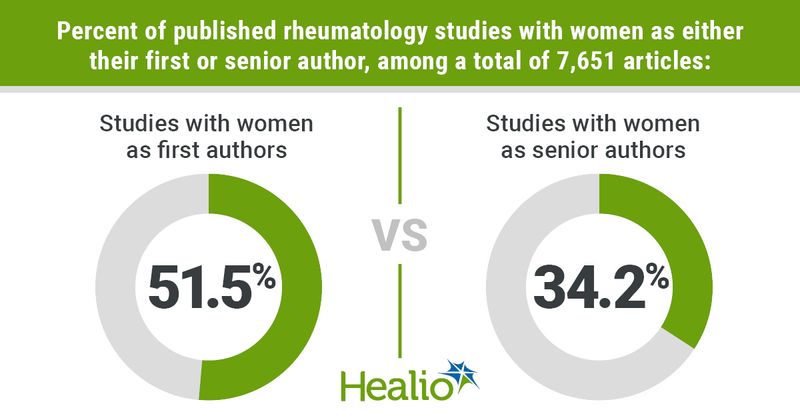Women remain underrepresented as senior authors for rheumatology research
Although there is gender parity regarding first-authorship in research articles, women in rheumatology are still underrepresented in senior authorship positions, according to findings published in Arthritis & Rheumatology.
“In academic medicine, clinical trial leadership is important for career advancement, prominence in the field and future funding opportunities,” Nicola Dalbeth, MBChB, MD, FRACP, of the University of Auckland in New Zealand, and colleagues wrote. “In oncology clinical trials, women are under-represented as lead investigators in industry-funded studies. Furthermore, in industry-funded collaborative cancer trials, women are underrepresented as first and senior authors, compared with trials not funded by industry. It is unknown whether funding source influences gender authorship for other specialties.”

To analyze the current representation of women as first and senior authors in rheumatology research articles, Dalbeth and colleagues reviewed all original articles published in general rheumatology journals with a 2016 Thomas Reuters “impact factor” of 3 or more. The included journals were Annals of the Rheumatic Diseases, Arthritis & Rheumatology, Rheumatology, Seminars in Arthritis & Rheumatism, Arthritis Research & Therapy, Joint Bone Spine, Arthritis Care & Research and Journal of Rheumatology.
In addition, the researchers reviewed original research articles on rheumatic diseases published in general medical journals with an impact factor of 15 or more. These included New England Journal of Medicine, The Lancet, Journal of the American Medical Association, The British Medical Journal, JAMA Internal Medicine and Annals of Internal Medicine. Focusing on the period between January 2015 and December 2019, the researchers included a total of 7,651 original articles in their analysis. Extracted data included gender of the first and senior author, disease category, research design and funding source.

According to the researchers, 51.5% (95% CI, 50.4% to 52.6%) of the included articles had women as first authors, but only 35.3% (95% CI, 34.2% to 36.4%) had women as senior authors. In addition, women were significantly less likely to be the first or senior author of articles involving randomized controlled trials, compared with other clinical research designs (P < .001).
Women were also less likely to be the first or senior author of articles reporting industryfunded, or industryinitiated, studies, compared with studies not funded by industry (P .01). Among articles involving industryfunded or initiated randomized controlled trials, women were first authors in 18.5% (95% CI, 13.8% to 24%) of studies, and were senior authors in 23.9% (95% CI, 18.6% to 29.8%).
According to Dalbeth, the methods used by the researchers did not allow them to analyze data on nonbinary authors.
“Although there is gender parity for first authorship, women are underrepresented in senior authorship positions of rheumatology research articles,” Dalbeth told Healio Rheumatology. “There is under-representation of women in both first and senior authorship positions in articles reporting rheumatology randomized controlled trials, especially those that are initiated by industry.”
“These findings are likely to reflect gender disparities in academic rheumatology, with women underrepresented in senior academic positions,” she added. “These findings highlight the importance of institutions and industry to take steps to ensure that women are represented equally.”
